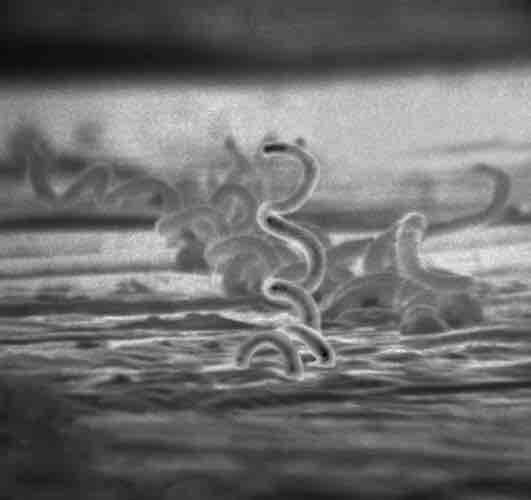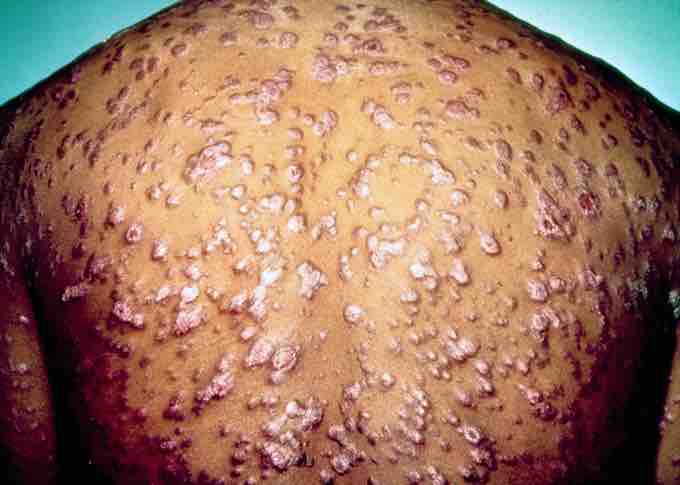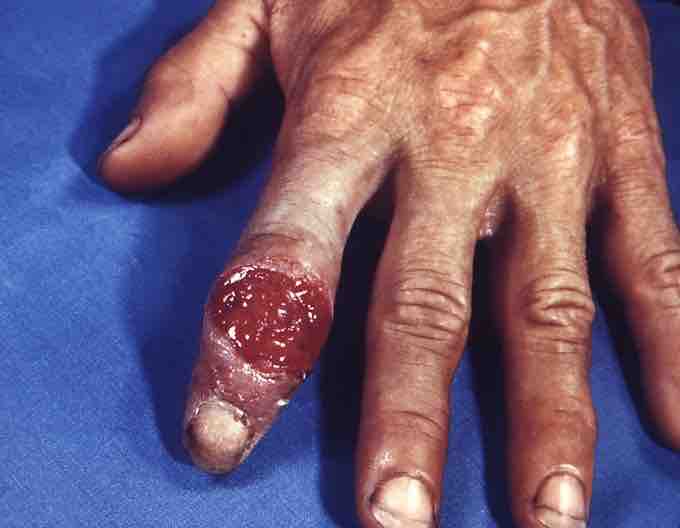Syphilis
Syphilis is a sexually transmitted infection (STI) caused by the spirochete bacterium Treponema pallidum .

Electron Microscopy of Treponema Pallidum
This electron micrograph shows Treponema pallidum on cultures of cotton-tail rabbit epithelium cells (Sf1Ep). It is the causative agent of syphilis.
FOUR STAGES OF SYPHILIS
The signs and symptoms of syphilis vary depending on which of the four stages it presents (primary, secondary, latent, or tertiary). The primary stage classically presents itself with a single chancre (a firm, painless, non-itchy skin ulceration) as shown in . Secondary syphilis shows itself with a diffuse rash that frequently involves the palms of the hands and soles of the feet . Latent syphilis displays little to no symptoms, and neurosyphilis (tertiary) can result in neurological and cardiac symptoms because the syphilis has been undiagnosed or untreated for many years.

Secondary Syphilitic Infection on the Posterior Aspect of the Torso
Dermatologic manifestations are the hallmark of secondary syphilis. Copper-red papules are most common, but macular, pustular, acneiform, psoriasiform, nodular, annular, or follicular variants can appear. The lesions characteristically do not itch, but may itch in some patients.

Primary Syphilitic Infection of the Finger
The chancre is usually firm, round, small, and painless, appearing at the spot where syphilis entered the body. It lasts three to six weeks and heals on its own. If adequate treatment is not administered, the infection progresses to the secondary stage.
DIAGNOSIS AND TREATMENT
Diagnosis is usually via blood tests, but the bacteria can also be visualized under a microscope. Syphilis can be effectively treated with antibiotics, specifically the preferred intramuscular penicillin G (given intravenously for neurosyphilis), or else ceftriaxone, and in those who have a severe penicillin allergy, oral doxycycline or azithromycin.
Syphilis is believed to have infected 12 million people globally in 1999, with more than 90 percent of cases in the developing world. Rates decreased dramatically after the widespread availability of penicillin in the 1940s. However, rates of infection have increased since the turn of the century in many countries, often in combination with human immunodeficiency virus (HIV). By some accounts, this has been attributed, in part, to unsafe sexual practices among men who have sex with men, increased promiscuity among all genders, prostitution, and decreasing use of barrier protection.
PRIMARY SYPHILIS
Primary syphilis is typically acquired by direct sexual contact with the infectious lesions of another person. Approximately three to 90 days after the initial exposure (average 21 days) a skin lesion, called a chancre, appears at the point of contact. This chancre is classically a single, firm, painless, non-itchy skin ulceration with a clean base and sharp borders between 0.3 and 3.0 cm in size. However, the lesion may take on almost any form. In the classic form, it evolves from a macule to a papule and finally to an erosion or ulcer. Occasionally, multiple lesions may be present, with multiple lesions more common when co-infected with HIV. Lesions may be painful or tender (in 30 percent of those infected), and they may occur outside of the genitals (2 to 7 percent). The lesion may persist for three to six weeks without treatment.
SECONDARY SYPHILIS
Secondary syphilis occurs approximately four to 10 weeks after the primary infection. While secondary disease is known for the many different ways it can manifest, symptoms most commonly involve the skin, mucous membranes, and lymph nodes. There may be a symmetrical, reddish-pink, non-itchy rash on the trunk and extremities, including the palms and soles of the feet. The rash may become maculopapular or pustular. It may form flat, broad, whitish, wart-like lesions known as condyloma latum on mucous membranes. All of these lesions harbor bacteria and are infectious.
Other symptoms may include fever, sore throat, malaise, weight loss, hair loss, and headache. Rare manifestations include hepatitis, kidney disease, arthritis, periostitis, optic neuritis, uveitis, and interstitial keratitis. The acute symptoms usually resolve after three to six weeks; however, about 25 percent of people may experience a recurrence of secondary symptoms.
NEUROSYPHILIS
Neurosyphilis occurs when syphilis is left untreated from many years. The brain and spinal cord become infected with the syphilis bacterium, Treponema pallidum, during the secondary stage of infection and can remain latent for 10 to 20 years after the initial infection. Eventually, this infection begins to damage the tissues of the brain and spinal cord, resulting in neurosyphilis. Neurosyphilis is characterized by neurological and psychiatric symptoms, such as confusion, blindness, abnormal gait and dementia. Left untreated, neurosyphilis symptoms will worsen over time and can lead to death. Treatment for neurosyphilis is the same as any other stage of syphilis, requiring only a short course of penicillin.
TRANSMISSION AND PREVENTION
Syphilis is transmitted primarily by sexual contact or during pregnancy from a mother to her fetus. The spirochete is able to pass through intact mucous membranes or compromised skin. Therefore, it is transmissible by kissing, or oral, vaginal, and anal sex. Approximately 30 to 60 percent of those exposed to primary or secondary syphilis will get the disease. It can be transmitted via blood products, but, many countries test for it, and thus the risk is low. The risk of transmission from sharing needles appears limited. Syphilis cannot be contracted through toilet seats, daily activities, hot tubs, or sharing eating utensils or clothing.
As of 2010, there is no vaccine effective for prevention. Abstinence from intimate physical contact with an infected person is effective at reducing the transmission of syphilis, as is the proper use of a latex condom. However, condom use does not completely eliminate the risk.